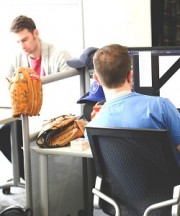During family dinners in my household, we’d all bring an item from the kitchen to the table. None was exempt from this ritual. No matter who cooked dinner that night, everyone ended up contributing to the meal because of what they brought to the table. What they brought was incidental–the fact they brought something was what was important.
The same applies in a work environment–especially in meetings. We all have different things we bring to the table. What we bring often depends on the role we have in the organization or the area of expertise we apply every day to our work. None of these are really any different than setting a dinner table – every part of the meal is important.
The Centerpiece Object: CEO
Every table often has a decorative centerpiece; it generally reflects the time of year or a mood that is trying to be set. While the table can be a metaphor for the company as a whole, the centerpiece is the thing that ties it all together. I’d liken it to the CEO or person ensuring the mandate and mission of the office is being met. The centerpiece is the focal point: the one thing we don’t lose sight of. If it’s a good centerpiece, you can’t help but admire it. If it’s not, you tend to toss it aside. Ideally, you need to get a good centerpiece.
The Dishes: Management Team
The plates and bowls are meant to take what’s offered and house them so they can be worked on. As with any project, if you put the wrong people in charge of it you’ll end up with a big mess. Similarly, you’re not going to serve soup on a plate. The right dishware is critical to a good meal and the right management are imperative in order to make sure things are properly handled. Not everyone is going to be right for the same tasks every time out, but if you know when and where to utilize these people you’ll have a far easier time managing things. But before you even begin to dig in, you’ll need…
The Utensils: Project Team
Not everything can be eaten with your hands. Most things can’t. The key to getting through a project is having the right tools at your disposal – and those often are the people working on it, day in and day out. They know how to attack the plan and the management team has made it easier for them to do so. They often bring things in that the management team can’t or doesn’t see. They are looking ahead with a different set of eyes. That’s why you don’t see a plate cut a steak. It’s just not “cut” out for it.
(Sorry about that pun. To be fair, I’ve lasted four months without using one.)
The Main Course: The Agenda
This isn’t a person or a role, this is simply what needs to be dealt with. If you have an under-developed agenda, you’re not going to enjoy your meeting very much. More often than not, you won’t even get anything done if it’s not clear and focused. I can tell you that when it comes to dinner, I’m not going to eat undercooked meat. You know why? Because I could get sick – or worse.
That’s what an “undercooked” agenda can do to your organization.
The Dessert: The End Result
Have you ever tried to bake a soufflé? If you have, you’ll know how challenging it is to keep it from falling flat (even if you haven’t, you’ve likely heard about how this can happen). A meeting is similar in that if you don’t handle it accordingly, the end result will fall flat. When a soufflé works out, it tastes great. But a flat one just comes off unappealing – not even worth eating, really. If you want to have a great ending to your meeting, handle it with care throughout. What that means for your office is dependent on a ton of things (your centerpiece comes to mind), but make sure you adhere to it as closely as possible. Otherwise your meeting will fall flat.
The Aperitif: The Rewards
This is post-meeting stuff, but if you are able to have everyone contribute their best stuff – bring something worthwhile to the table and play to your strengths – there will be cause for celebration. Celebration is crucial to team building, so make sure you do it when it is warranted.
When everyone gets together in the office for a meeting, keep in mind the idea that if everyone is asked to bring something to the table, they will. Those that want to put their best forward, will. Those that are interested in the organization’s growth as well as their own, will.
Those that don’t will be left sitting somewhere else altogether.
bring something to the table, what to bring to a meeting, things to bring to a meeting, meeting 101






Discussion